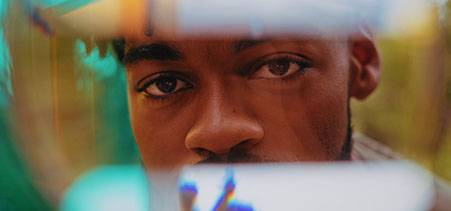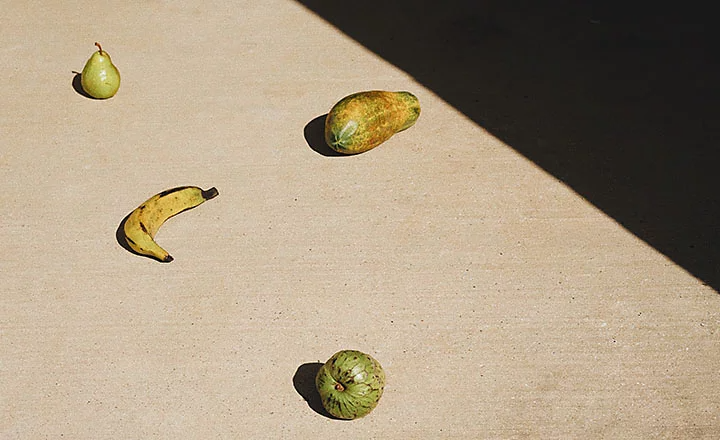Photography
Find your truth in fine art photography.
Fine art photography overlaps with landscape, portraiture and many other styles of capturing images. But it is characterised by the approach an artist uses to make photos in a distinct way.

What makes fine art photography distinct?
Exploring the world of fine art photography begs the age-old question: “What is art?” It’s a loaded question and one that often comes down to the intention of the artist. Fine art is set apart by the approach an artist takes when creating their work. “Fine art photography is the intentional use of photography as your artistic medium of choice, used to further your conceptual idea,” explains professor and photographer Ariel Wilson. That distinction sets fine art photos apart from images quickly snapped on a camera.
"Different from photojournalism or commercial photography, “fine art is an individual’s pursuit of a certain interest that isn’t commissioned or propelled by an external influence,” explains photographer and professor Adam Long." Commercial photography is created with a purpose, to showcase products and generate sales. Photojournalism and some documentary photography are all about capturing truth in what’s being photographed and are meant to document a specific subject matter or scene with minimal bias. “There’s a conceptual difference when it comes to fine art,” notes Long.
Exploring fine art photography as an art form.
Fine art photography is an opportunity for an artist to explore ideas and communicate. The resulting images can be landscapes, portraits, still lifes or abstract images. But before jumping in and creating your own fine art images, it’s important to learn from the pros and appreciate the work within the genre. Exploring this work can help you to identify the kind of art you want to create.

Discovering landscape photography.
From historic landscape photographers like Ansel Adams to contemporary pros like Dan Tom, photographing landscapes often falls within the realm of fine art. These artists communicate the truth of a scene and strive to share it with the world. There’s a lot to learn about environmental causes and the nature of the world within the work of landscape photographers.
Looking into fine art portrait photography.
Portraiture can be a wonderful example of fine art, but not all portraits are considered fine art. Headshots created for a business website, for example, wouldn’t be categorised as fine art. But portraits created with intention, like those by Justin Dingwall or the work of the legendary Robert Mapplethorpe, strive to represent the world and communicate an attempt to understand it. People are drawn to looking at other people and portraits and self-portraits are a wonderful opportunity for capturing the experience of the human condition.

Finding the quiet truths within still life photography.
A still life is a collection of inanimate objects arranged as the subject of a composition. There are countless famous still life paintings and photos in museums around the world. While still life photographs often take the form of product photography today, by stepping out of the box, like photographer Elise Mesner, you can capture something unique and fanciful. Taking a whimsical approach to capturing something simple can allow you to create a distinctive voice and find a new perspective on that item.
Pursuing your passions.
The world of photography is practically endless and these are just a few of the forms fine art photographs can take. If street photography, fashion photography or astrophotography is what interests you, do some research and find the famous work within those disciplines that inspires you. Learning from pros is an invaluable tool for bettering your skills.
What makes great fine art photographs.
While art is subjective, the same rules that make a commercial or product photo successful also make a fine art photograph. Photographer and teacher Tina Tryforos suggests focusing on “compelling content that pulls the viewer in, really good composition and beautiful light.”
“Great fine art photos often have three things,” photographer and professor Ariel Wilson notes. “They have an aesthetic draw and are visually appealing, are well constructed and crafted and have some form of conceptual engagement.” If you can create an interesting image that’s well constructed and related to a larger idea, you can create fine art photos.

The role of post-processing.
You don’t need to capture your image perfectly in the camera. Post-processing tools, like Adobe Photoshop or Lightroom, can help you to transform and elevate your image. “Use any means necessary to get your point across,” notes Long. When it comes to photos and digital art, everything is up for interpretation. It’s all art. For example, a photo of an apple isn’t an apple — it’s a representation of an apple. And depending on the light, exposure and composition of that image, the intent of the photo changes.
Tips for fine art beginners.
Learn your tools.
To create great fine art photos, you need to understand the tools at your disposal. Get a handle on how to use your camera and test out different settings. When you understand the intricacies of depth of field, focal length and shutter speed, you can use those tools to better convey your ideas.
Change your perspective.
Try photographing a mundane object 100 times to see the different perspectives and visuals you can create. While 95 per cent of those images may be useless, you’ll better understand your tools and you can end up with five very interesting images. If you’re used to shooting in color, try creating black-and-white photographs for a change. Mixing up the way you create your photos can help you to elevate your ideas and find a new perspective.

Master the art of composition.
When you understand the rules of composition, like the rule of thirds, you can then intentionally break those rules to further convey your ideas. The next time you’re doing a photoshoot, take some extra shots at odd or interesting angles. By comparing the images that either follow or break standard composition rules, you can find new ways to draw focus or communicate ideas.
Focus on your interests.
The best fine art happens when artists explore the topics that they’re passionate about. “Fine art photos can acknowledge the politics of representation and materiality,” notes Wilson. As the artist, it’s up to you what ideas you want to pursue and explore, but it’s easier to create worthwhile work when those ideas are important to you.
Pursuing the art of photography.
Fine art galleries, museums, businesses and homes are the primary places fine art photos are displayed. Creating high-quality fine art photography prints is important for success. Whether you use a dark room to print your photos from film or you perfect images digitally and have them printed, make sure you view your photos in the physical world. A photo communicates different ideas when seen on a phone screen than when it’s on the wall of an art gallery. Size, scale and physicality all change the way a viewer interprets your work of art.
“Not everyone can be a fine art photographer exclusively. A lot of people do a lot of different things,” notes Tryforos. Because fine art is not usually created with a commercial purpose, most people can’t focus exclusively on creating fine art. But that doesn’t mean you shouldn’t make it.
Whether you pursue photography as a hobby or are a professional photographer who creates fine art on the side, you can keep making photos to share your ideas with the world. Fine art photography differs conceptually from other photography disciplines because it’s driven by the artists’ interests, ideas and personal goals. Now’s the perfect time to explore your passions and make fine art photos that interest you.
Contributors